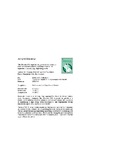Mostrar el registro sencillo del ítem
Elevated CO2 improved the growth of a double nitrate reductase defective mutant of Arabidopsis thaliana: the importance of maintaining a high energy status
| dc.creator | Jáuregui Mosquera, Iván | es_ES |
| dc.creator | Aparicio Tejo, Pedro María | es_ES |
| dc.creator | Baroja Fernández, Edurne | es_ES |
| dc.creator | Ávila, Concepción | es_ES |
| dc.creator | Aranjuelo Michelena, Iker | es_ES |
| dc.date.accessioned | 2020-10-14T10:56:01Z | |
| dc.date.available | 2020-10-14T10:56:01Z | |
| dc.date.issued | 2017 | |
| dc.identifier.issn | 0098-8472 | |
| dc.identifier.uri | https://hdl.handle.net/2454/38385 | |
| dc.description.abstract | Impairments in leaf nitrogen (N) assimilation in C3 plants have been identified as processes conditioning photosynthesis under elevated [CO2], especially when N is supplied as nitrate. Leaf N status is usually improved under ammonium nutrition and elevated [CO2]. However, ammonium fertilization is usually accompanied by the appearance of oxidative stress symptoms, which constrains plant development. To understand how the limitations of direct fertilization with ammonium (growth reduction attributed to ammonium toxicity) can be overcome, the effects of elevated [CO2] (800 ppm) exposure were studied in the Arabidopsis thaliana double nitrate reductase defective mutant, nia1-1/chl3-5 (which preferentially assimilates ammonium as its nitrogen source). Analysis of the physiology, metabolites and gene expression was carried out in roots and shoot organs. Our study clearly showed that elevated [CO2] improved the inhibited phenotype of the nitrate reductase double mutant. Both the photosynthetic rates and the leaf N content of the NR mutant under elevated CO2 were similar to wild type plants. The growth of the nitrate reductase mutant was linked to its ability to overcome ammonium-associated photoinhibition processes at 800 ppm [CO2]. More specifically: (i) the capacity of NR mutants to equilibrate energy availability, as reflected by the electron transport equilibrium reached (photosynthesis, photorespiration and respiration), (ii) as well as by the upregulation of genes involved in stress tolerance were identified as the processes involved in the improved performance of NR mutants. | en |
| dc.description.sponsorship | This work has been funded by the Spanish National Research and Development Programme (AGL2009-13339-C02-02, AGL2011-30386-C02-02 and AGL2012-37815-C05-05). Ivan Jauregui was the holder of a FPI fellowship from the Spanish Ministry of Economy and Competitiveness. | en |
| dc.format.extent | 41 p. | |
| dc.format.mimetype | application/pdf | en |
| dc.format.mimetype | application/zip | en |
| dc.language.iso | eng | en |
| dc.publisher | Elsevier | en |
| dc.relation.ispartof | Environmental and Experimental Botany, 2017, 140, 110-119 | en |
| dc.rights | © 2017 Elsevier B.V. This manuscript version is made available under the CC-BY-NC-ND 4.0 | en |
| dc.rights.uri | http://creativecommons.org/licenses/by-nc-nd/4.0/ | |
| dc.subject | [CO2] | en |
| dc.subject | Plant physiology | en |
| dc.subject | Nitrate reductase | en |
| dc.subject | Ammonium | en |
| dc.subject | Photosynthesis | en |
| dc.subject | Root-to-shoot | en |
| dc.subject | Transcriptomics | en |
| dc.subject | Redox | en |
| dc.title | Elevated CO2 improved the growth of a double nitrate reductase defective mutant of Arabidopsis thaliana: the importance of maintaining a high energy status | en |
| dc.type | info:eu-repo/semantics/article | en |
| dc.type | Artículo / Artikulua | es |
| dc.contributor.department | Ciencias del Medio Natural | es_ES |
| dc.contributor.department | Natura Ingurunearen Zientziak | eu |
| dc.contributor.department | IdAB. Instituto de Agrobiotecnología / Agrobioteknologiako Institutua | es |
| dc.rights.accessRights | info:eu-repo/semantics/openAccess | en |
| dc.rights.accessRights | Acceso abierto / Sarbide irekia | es |
| dc.identifier.doi | 10.1016/j.envexpbot.2017.06.003 | |
| dc.relation.projectID | info:eu-repo/grantAgreement/MICINN//AGL2011-30386-C02-01/ES/ | en |
| dc.relation.projectID | info:eu-repo/grantAgreement/MINECO//AGL2012-37815-C05-05/ES/ | en |
| dc.relation.publisherversion | https://doi.org/10.1016/j.envexpbot.2017.06.003 | |
| dc.type.version | info:eu-repo/semantics/acceptedVersion | en |
| dc.type.version | Versión aceptada / Onetsi den bertsioa | es |



